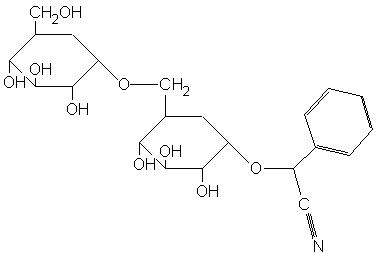‘Vitamin B17’ is the designation given to a group of chemicals called β-cyanophoric glycosides. Also known as nitrilosides, they are naturally occurring plant compounds which contain a cyanide group. One of the best known nitriloside is called amygdalin, and its structure is shown in figure 1. Amygdalin is found in the kernels of most seeds, but plants of the genus Prunus (almonds, apricots, cherries, peaches, plums and nectarines) are particularly rich sources. Nitrilosides are also found in lower concentrations in apple seeds, flax seeds, grasses and cereals. The diets of primitive man and most fruit or seed eating animals are naturally rich in nitrilosides. Amygdalin has been used traditionally as a cancer treatment and its use can be historically dated back to at least the 19th century, where it was used in parts of Europe.
 Figure 1. The molecular structure of amygdalin.
Figure 1. The molecular structure of amygdalin.
Laetrile is a synthetic compound that shares some of the molecular structure and metabolic similarities with amygdalin and is also used as a cancer treatment. Laetrile and amygdalin are controversial because they both contain a cyanide group in their molecular structure which can be hydrolysed to form hydrogen cyanide (HCN) in humans using the enzyme β-glucosidase. Hydrogen cyanide is toxic to cells and this is suggested to be the process by which nitrilosides are able to affect cancer cells. Metabolism of nitrilosides results in the production of hydrogen cyanide, a sugar and benzaldehyde or acetone. The hydrogen cyanide is then converted to the less toxic thiocyante (SCN–) by the mitochondrial enzyme rhodenese, and the bezaldehyde is oxidised to benzoic acid. Mainstream medicine has repeatedly claimed that laetrile is not effective against cancer, despite a large body of anecdotal evidence to the contrary.
Below is a video narrated by G. Edward Griffin, that explains the possible protective effects of vitamin B17 against cancer.
RdB
